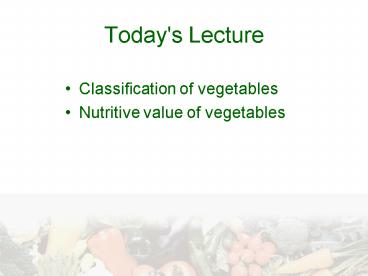Today's Lecture - PowerPoint PPT Presentation
1 / 18
Title:
Today's Lecture
Description:
... celery, chard, chinese cabbage, collard, kale, lettuce, spinach ... kohlrabi, leek, mustard, onion, pea, radish, rhubarb, rutabaga, spinach, turnip ... – PowerPoint PPT presentation
Number of Views:222
Avg rating:3.0/5.0
Title: Today's Lecture
1
Today's Lecture
- Classification of vegetables
- Nutritive value of vegetables
2
Classification of Vegetables
- Why do we need to classify vegetables?
- Whats the name?
- Botanical classification
- What part do you eat?
- Edible plant part
- Where and when do you grow it?
- Temperature requirements
- How does it grow?
- Life cycle
3
Botanical Classification
- Division Spermatophyta
- Class Angiospermae
- Subclass Monocot or Dicot
- Family
- Genus
- Species
- Group or subspecies
- Cultivar
4
Important Monocots
- Alliaceae (Allium Family)
- Onion, Garlic, Leek, Shallot
- Gramineae (Grass Family)
- Sweet corn
- Liliaceae (Lily Family)
- Asparagus
5
Most Vegetables are Dicots
- Compositae (Sunflower Family)
- Lettuce, Globe artichoke, Jerusalem artichoke
- Convolvulaceae (Morning-glory Family)
- Sweet potato
- Cruciferae (Mustard Family)
- Cabbage, broccoli, cauliflower, kohlrabi,
collard, kale, brussels sprouts, Chinese cabbage,
turnip, radish
6
- Cucurbitaceae (Gourd Family)
- Cucumber, watermelon, cantaloupe, honeydew melon,
summer squash, winter squash, pumpkin - Leguminosae (Pea/Bean Family)
- Snap bean, pea, cowpea, black-eyed pea
- Malvaceae (Cotton Family)
- Okra
- Solanaceae (Nightshade Family)
- Tomato, pepper, eggplant, potato
- Umbelliferae (Parsley Family)
- Celery, carrot, parsnip, parsley
7
Edible Parts - Underground
- Roots
- Beet, carrot, parsnip, radish, rutabaga, sweet
potato, turnip - Tuber
- Potato, Jerusalem artichoke
- Bulb
- Garlic, leek, onion
8
Edible Parts Above ground
- Stem
- Asparagus, kohlrabi
- Leaf
- Brussels sprout, cabbage, celery, chard, chinese
cabbage, collard, kale, lettuce, spinach - Floral
- Broccoli, cauliflower, globe artichoke
9
Edible Parts Above ground
- Immature Fruit
- Cucumber, eggplant, okra, snap bean, summer
squash, sweet corn - Mature Fruit
- Honeydew, muskmelon, cantaloupe, pepper, podded
pea, pumpkin, tomato, watermelon, winter squash - Seed
- Cowpea, garden pea, soybean, lima bean
10
Classification by Temperature
- Cool season crops
- Hardy
- Asparagus, broccoli, brussels sprouts, cabbage,
collard, garlic, kale, kohlrabi, leek, mustard,
onion, pea, radish, rhubarb, rutabaga, spinach,
turnip - Half-hardy
- Beet, carrot, cauliflower, celery, chard, chinese
cabbage, globe artichoke, Jerusalem artichoke,
lettuce, parsnip, potato
11
Warm Season Crops
- Tender
- Cowpea, snap bean, soybean, sweet corn, tomato
- Very Tender
- Cucumber, cantaloupe, eggplant, honeydew, lima
bean, okra, pepper, pumpkin, squash, sweet
potato, watermelon
12
Classification by Life Cycle
- Perennials
- Asparagus, eggplant, garlic, globe artichoke,
Jerusalem artichoke, lima bean, pepper, potato,
rhubarb, sweet potato, tomato - Biennials
- Beet, broccoli, Brussels sprout, cabbage, carrot,
cauliflower, celery, chard, Chinese cabbage,
collard, kale, kohlrabi, leek, onion, parsnip
rutabaga, turnip
13
Annual Crops
- Cowpea, cucumber, cantaloupe, honeydew, lettuce,
okra, pea, pumpkin, snap bean, soybean, spinach,
squash, sweet corn, watermelon - Text also lists
- Broccoli, cauliflower, Chinese cabbage, mustard
(vernalization) - Potatoe?
14
Nutritive Value of Vegetables
- Mom always said eat your vegetables
- Vital source of essential minerals, vitamins and
dietary fiber - Handout - Also a source of carbohydrates, protein and
energy - More recently recognized as a vital source for
phytochemicals
15
Overview of the health benefits of fruit and
vegetable consumption for the dietetics
professional Selected literature.Journal of the
American Dietetic Association, Dec, 2000, by
Maryann S. Van Duyn, Elizabeth Pivonka
- Reduced Cancer Risk
- 20 reduction
- Reduced risk of Coronary Heart Disease
- 20-40 reduction
- Reduced risk of Stroke
- up to 25 reduction
- Also Cataracts, Chronic Obstructive Pulmonary
Disease, Diverticulosis, and Hypertension
16
(No Transcript)
17
ANTICANCER AGENTS IN FOODS
- Carotenoids - Antioxidant
- Tomato, watermelon, grapefruit
- Flavonoids - Antioxidant
- Citrus, most vegetables, tea, wine
- Sulfides - stimulant
- Onions and Garlic
- Glucosinolates/Indoles - protectant, inducer
- Crucifer Family
18
(No Transcript)





























